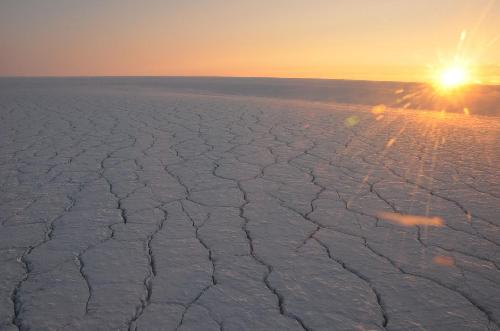Clouds play a bigger role in the melting of the Greenland ice sheet than was previously assumed. Compared to clear skies, clouds enhance the meltwater runoff by a third. Those are the findings of an international study that was coordinated by KU Leuven and published in Nature Communications.
Greenland's ice sheet is the second largest ice mass in the world - the largest is Antarctica. The ice sheet is losing mass at a high speed and increasingly contributes to the sea level rise on our planet. The role of clouds in this loss of snow and ice has never been calculated before, nor can it be deduced from theoretical climate models. For lack of observations, the different models do not agree on the importance of clouds over the ice sheet.
"Clouds always have several effects", lead author Kristof Van Tricht explains. "On the one hand, they help add mass to the ice sheet when it snows. On the other, they have an indirect effect on the ice sheet as well: they have an impact on the temperature, and snow and ice react to these changes by melting and refreezing. That works both ways. Clouds block the sunlight, which lowers the temperature. At the same time, they form a blanket that keeps the surface warm, especially at night. In this study, we examine the net result of these two indirect effects on the entire Greenland ice sheet."

The researchers used specific satellite observations to detect clouds over the Greenland ice sheet from 2007 to 2010. They compared the results with ground-based observations. The researchers combined these observations with snow model simulations and climate model data to map the net effect of clouds.
"Over the entire Greenland ice sheet, clouds raise the temperature, which triggers additional meltwater runoff: 56 billion tons per year - a third more than clear skies. Contrary to what you would expect, this effect is not so much visible during the daytime melting process, but rather during the following night. A snowpack is like a frozen sponge that melts during the day. At night, clear skies make a large amount of meltwater in the sponge refreeze. When the sky is overcast, by contrast, the temperature remains too high and only some of the water refreezes. As a result, the sponge is saturated more quickly and excess meltwater drains away."
The study highlights the need for accurate cloud representations in climate models that aim to estimate the amount of meltwater. "With climate change at the back of our minds, and the disastrous consequences of a global sea level rise, we need to understand these processes to make more reliable projections for the future. Clouds are more important for that purpose than we used to think."




Comments